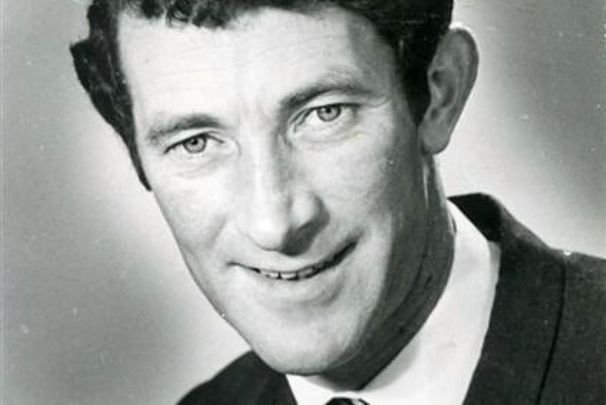Editor's Note: Larry Cunningham, an Irish country music singer who was one of the leading figures of the showband scene in the 1960s and 1970s, was born on February 13, 1938.
Regarded as a trailblazer and a legend in the Irish country music scene of the 1960s and 70s, Cunnigham and his beautiful voice were known as one of the kings of the showband scene in Ireland at the time. Cunningham became the first Irish artist to break into the British charts, one of the many "firsts" he accomplished over his decades of music-making alongside his band The Mighty Avons.
In celebration of his life, we remember the iconic singer and the impact he and his music had on Ireland's youth at the time. Below is an article that was written by Cormac MacConnell shortly after Cunningham's death in 2012 paying tribute to the iconic singer.
Meeting with Irish singer Larry Cunningham
The last time I met and interviewed the great Irish showband star Larry Cunningham he was in great form altogether in sunny Salthill as we discussed such recent highlights of his career as leading the first Irish showband to play Carnegie Hall, and the craic of having earlier performed in Monaco for Princess Grace.
He was a lovely man. He was special. He had the gift of a mighty country music voice and, despite his huge success in the entertainment business in the peak era of the unique showbands, he never lost the common touch.
It was with real regret I heard of his death after an illness a couple of weeks ago at the age of 74 years. May he rest in peace.
This yarn, I suppose, is of most interest to the thousands of you over there who are Irish-born and who certainly danced many of your younger nights away to the sound and beat of the Mighty Avons showband fronted by the farmer's son from Granard.
Your young dancing and courting days happened during an unusual, largely rural, social period when the hundreds of new showbands blossomed like musical mushrooms in every province. They supplanted the staid sit-down orchestras and dance bands that had ruled the roost in the forties and fifties.
They underscored an exciting new Ireland of that time. Largely playing covers of the popular chart hits of the time, they also enthusiastically played other music like jazz and swing and South American and mainland European tempos.
They wore bright mohair suits and flung themselves around the stages in dance halls and the summertime marquees in complete contrast to the orchestras. They were flamboyant and caught the new mood
Amazingly, many of you will remember, they were silenced in the provinces during the seven penitential weeks of Lent because of the ruling power then of the Church! That was when they "emigrated" briefly to England and the United States to play for the Irish dancers there.
Larry Cunningham represented rural Ireland among the showbands
The showbands represented a small industry. They gave good employment to thousands of musicians in their 20-year heyday. Their presence created a chain of huge commercial ballrooms in all counties -- the largest of these operated by the family of former Taoiseach (Prime Minister) Albert Reynolds.
All the bands were fronted by featured vocalists. All of them had their own followings.
And if the Royal Showband led by Brendan Bowyer and the Capital led by the late Butch Moore and the Miami fronted by Dickie Rock were the top three nationally then, for sure, the Mighty Avons fronted by Larry Cunningham was always right up there. In many regions of the west, actually, they would always draw the biggest attendance.
I think there were three or four main factors involved in this. If the other stars like Bowyer and Moore and Rock and their bands were drawn from urban backgrounds, and subtly reflected this in their performances, then the Mighty Avons were truly a rural band in every way.
The life of Irish singer Larry Cunningham
Larry was born and raised on a 50-acre farm and somehow looked and acted like a farmer even in a mohair suit. Several members of the Avons were also farm bred. There was often farming talk with their fans after the dances were over.
Also, their music tended more towards the old country and western music, always popular in the provinces from the beginning. And, critically, in the Bill Haley years, with a better beat for the new craze of jiving than pure pop.
Some of the commercial ballrooms even had notices banning jiving stiletto heels on their sprung maple floors initially installed for waltzing and fox-trotting beneath all the spinning crystal balls where boy met girl and torrents of marriages inevitably followed. Ah yes, ye remember it well.
But it was Larry Cunningham's gift and good fortune that his Longford voice was at least as richly deep and low textured (right to the end!) as that of the then immensely popular American country singer Jim Reeves.
Larry Cunningham's deep Longford voice easily made him a favorite
He built up a repertoire of covers of Reeves hits such as "He'll Have to Go" in the early sixties, and his real breakthrough nationally came in Donegal in 1963 when he deputized in Lifford for Reeves himself after Reeves walked off the stage because the piano was out of tune.
It is a fact that Reeves died in a plane crash the following year, but by then the Irish dancers were even fonder of Larry's renderings than they were of the originals. And that began a fruitful half-century in the entertainment business for the farmer's son from Longford.
Too bad that he had to go from us so relatively early. He was singing away right until the end.
Only a bare handful of local showbands survive today. Most of the old ballrooms that Larry filled down the decades are either closed or converted to other uses, typically warehousing.
The social scene in rural Ireland is now dominated by nightclubs and discos in the nearest towns. Nobody jives anymore except at family weddings or in Lisdoonvarna each September. (Is it the same over there?)
But Larry Cunningham's easy, treacly voice, intact to the end, was always popular and sought after. He will be missed at many levels, not just by his family and close friends but by an Ireland with a continuing warm folk memory.
I have two of his many popular CDs and I'm listening now, almost with tears in my eyes, to his version of "Adios Amigo."
* Originally published in 2012, last updated in February 2025.




Comments